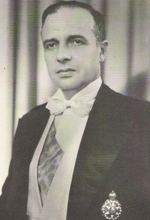Name Prince Henrique | ||
Period 14 November 1921 – 5 July 1981 Predecessor Isabel, Princess Imperial of Brazil Successor Prince Luiz Gastao of Orleans-Braganza Born 13 September 1909
Boulogne-Billancourt, France ( 1909-09-13 ) Died 5 July 1981(1981-07-05) (aged 71)
Vassouras, Brazil Spouse Princess Maria Elisabeth of Bavaria Issue Prince Luiz Gastao
Prince Eudes
Prince Bertrand
Princess Isabel
Prince Pedro
Prince Fernando
Prince Antonio
Eleanora, Princess of Ligne
Prince Francisco
Prince Alberto
Princess Maria Teresa
Princess Maria Gabriela | ||
Prince Pedro Henrique of Orléans-Braganza (Portuguese: Pedro Henrique Afonso Felipe Maria Miguel Gabriel Rafael Gonzaga de Orléans e Bragança; 13 September 1909 – 5 July 1981), was a great-grandson of the last emperor of Brazil, Pedro II, and one of two claimants to the abolished throne.
Contents
Early life in Europe
He was born in 1909 in France at Boulogne-sur-Seine during the exile of the Brazilian imperial family, which had been deposed in 1889. His father, Prince Luiz of Orléans-Braganza, was the second son of Isabel, Princess Imperial of Brazil, and Prince Gaston d'Orléans, comte d'Eu. His mother was Princess Maria Pia of Bourbon-Two Sicilies. His paternal grandmother, Isabel, Princess Imperial of Brazil, was the heir to the defunct Brazilian throne. The year before Pedro Henrique's birth, she recognized his father, Luiz, as the heir to the succession when Luiz's elder brother, Pedro de Alcântara, Prince of Grão-Pará, signed a renunciation of his claim to the throne on behalf of himself and his descendants.

Thus, at birth Prince Pedro Henrique received the title of Prince of Grão-Pará, according to Article 105 of the Constitution of 1824. He was baptized in the chapel of the Château d'Eu with the waters of the fountain taken from Largo da Carioca, in Rio de Janeiro. His godparents were his paternal grandmother, Princess Isabel of Brazil, and maternal grandfather, Prince Alfonso, Count of Caserta and Head of the Royal House of the Two Sicilies. The prince and his family lived between the Castle d'Eu and the palace of Boulogne-sur-Seine, both belonging to the Imperial Family. He was raised primarily by his grandmother, Princess Isabel, and numerous preceptors imbued to educate him as future emperor of Brazil.
In 1920, his father died in Cannes, France, victimized by injuries acquired in the trenches of the First World War. Also in 1920, the decree of banishment is revoked by the then President Epitácio Pessoa. The grandfather of Prince Pedro Henrique, Count d'Eu, leads part of the Imperial Family back in Brazil. Princess Isabel didn't travel because she was old and sick, making the trip not recommended. Still, Prince Pedro Henrique and Count d'Eu did not stay long in Brazil, because their lives were consolidated in Europe, and decided to go back there.
Given the death of his father in 1920, Prince Pedro Henrique became Prince Imperial of Brazil, but on 14 November 1921, Princess Isabel died at the Castle d'Eu. So, at age of 12 Prince Pedro Henrique became the head of the imperial family. Had he became Emperor, his imperial name would be Dom Pedro III.
He continued living in France with his mother, Princess Maria Pia of Bourbon-Sicilies, where she thought he could get better education with his brothers Prince Luiz Gastão of Orléans-Bragança and Princess Pia Maria of Orléans-Braganza. Pedro Henrique was educated in France at the Ecôle des Sciences Politiques in Paris. He was described by his grandmother as "a very intelligent child".
In 1925, at the age of 16, the Brazilian government ruled against his request to serve in the military.
Life in Brazil
Pedro de Alcântara, Prince of Grão-Pará, died in 1940.
Pedro Henrique was only able to return to Brazil in 1945, when the Second World War ended. He settled first in Petrópolis, Rio de Janeiro, in the palace of the Grão-Pará, and then in the neighborhood of Retiro, in Petrópolis. His cousin, Prince Pedro Gastão, the eldest son of Pedro de Alcântara, Prince of Grão-Pará, challenged Pedro Henrique's right to the succession in 1946, on the basis that his father's renunciation had no legal force.
In 1951, D. Pedro Henrique bought a farm, Fazenda Santa Maria, in the town of Jacarezinho, interior of Paraná, where he launched as a farmer. In 1965, he returned to the state of Rio de Janeiro, settling in Vassouras, an important city in the days of Empire for coffee production. On site called Santa Maria, Prince Pedro Henrique resided until the end of his life. He was active in the monarchist movement.
On his death in 1981, Pedro Henrique's claim to the throne passed to his eldest son, Prince Luiz Gastão.
Titles
Honors
Dom Pedro Henrique was Grand Master of the following Brazilian Orders:
He was a recipient of the following foreign honors:
Marriage and children
Pedro Henrique married Princess Maria Elisabeth of Bavaria at Schloss Nymphenburg, Bavaria, on 19 August 1937. They had twelve children.
